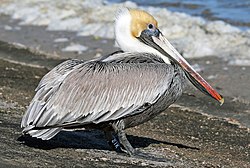I drove Ken and my mom up to Bodega Bay for lunch. It was a cloudy cool day, but felt good to get out near the water and breath some fresh air. Mom and I caught up on all the latest chit chat and we all had a delicious lunch. I think the pelicans were doing a good job of getting some food too. Everybody's tummies looked full. Thanks for lunch, Mom! I thought these were storks until I looked them up. The colors on their necks, bills, and heads are marvelous and remind me of the colors of our U.S. flag. Maybe this should have been our national bird. Of course, with all the political stuff (stuff is a nice word - I really mean ridiculous crap - which still sounds too nice) going on these days, who knows how long we will continue to be a nation.
Brown Pelican
From Wikipedia, the free encyclopedia
| Brown Pelican | |
|---|---|
 |
|
| Conservation status | |
| Scientific classification | |
| Kingdom: | Animalia |
| Phylum: | Chordata |
| Class: | Aves |
| Order: | Pelecaniformes |
| Family: | Pelecanidae |
| Genus: | Pelecanus |
| Species: | P. occidentalis |
| Binomial name | |
| Pelecanus occidentalis Linnaeus, 1766 |
|
The Brown Pelican occurs on both coasts in the Americas. On the Atlantic Coast and Gulf Coast they distribute from Nova Scotia to Venezuela, and to the mouth of the Amazon River. On the Pacific Ocean they are found from British Columbia to south central Chile, and including the Galapagos Islands.[2] Some immature birds may stray to inland freshwater lakes. After nesting, North American birds move in flocks further north along the coasts, returning to warmer waters for winter. Their young are hatched in broods of about 3, and eat around 150 lbs. of fish in the 8–10 month period they are cared for.
This bird is distinguished from the American White Pelican by its brown body and its habit of diving for fish from the air, as opposed to co-operative fishing from the surface. It eats mainly fish and amphibians as well as crustaceans. Groups of Brown Pelicans often travel in single file, flying low over the water's surface.
The nest location varies from a simple scrape on the ground on an island to a bulky stick nest in a low tree. These birds nest in colonies, usually on islands.


No comments:
Post a Comment